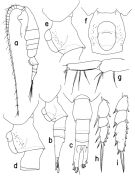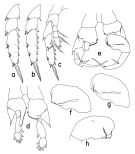|
|
 |
|
Calanoida ( Order ) |
|
|
|
Arietelloidea ( Superfamily ) |
|
|
|
Heterorhabdidae ( Family ) |
|
|
|
Heterostylites ( Genus ) |
|
|
| |
Heterostylites echinatus Park, 2000 (F,M) | |
| | | | | | | Ref.: | | | Park, 2000 (p.48, figs.F,M, Rem.) |  issued from : T. Park in Bull. Scripps Inst. Oceanogr. Univ. California, San Diego, 2000, 31. [p.180, Fig.28]. Female: a, habitus (left side); b, c, urosome (left, dorsal, respectively); d, first 2 urosomal somites (left); e, genital somite with arthrodial membrane on ventral side extended (left side); f, genital somite (ventral); g, basipod of right Mxp (anterior); h, exopod of P1 (anterior); i, exopod of P2 (anterior). Nota: Prosome length: 2.28-2.64 mm.
|
 issued from : T. Park in Bull. Scripps Inst. Oceanogr. Univ. California, San Diego, 2000, 31. [p.181, Fig.29]. Female: a, exopod of P3 (anterior); b, exopod of P4 (anterior); c, P5 (anterior). Male: d, P5 (distal exopodal segments omitted), anterior; e, P5 (endopods omitted), posterior; f, second exopodal segment of right P5 (posterior); g, idem (tilted clockwise); h, idem (anterior).
|
 Heterostylites echinatus Heterostylites echinatus female: 1 - Dorsally, genital somite widest at middle. 2 - Ventrally, genital operculum much wider than 1/2 width of somite (Fig.28-f). 3 - Laterally, straight ventral margin of genital somite not extending beyond posterior end of genital operculum (Fig.28-d). 4 - Mxp basis with spinules on distal part (Fig.28-g).
|
 Heterostylites echinatus Heterostylites echinatus male: 1 - Basal lobe of right P5 relatively short (Fig.29-d); basal lobe of left P5 low and wide. 2 - In 2nd exopodal segment of right P5, medial projection with a short serrated process (Fig.29-f). 3 - Mxp basis without spinules on distal aprt (Fig.28-g).
| | | | | Compl. Ref.: | | | Park & Ferrari, 2009 (p.143, Table 8, biogeography) | | | | NZ: | 1 | | |
|
Distribution map of Heterostylites echinatus by geographical zones
|
| | | | Loc: | | | E Pacif. (off W central America, off SW Mexico, S Baja California, G. of Panama, off Ecuador)
Type locality: 13°33'N, 98°36'W. | | | | N: | 1 | | | | Lg.: | | | (824) F: 3,92-3,32; M: 3,88-3,28; {F: 3,32-3,92; M: 3,28-3,88} | | | | Rem.: | Park (2000, p.49) to points to the similarity between H. echinatus and H. longioperculis, but can be distinguished. The females of these two species can be distinguished from each other by the shape of the 2nd urosomal somite, which in lateral view has a straight ventral margin in H. longioperculis, but the same margin in H. echinatus has a swelling in the posterior half. The outer exopodal spines of P1 and P2 are better developed in H. echinatus than in H. longioperculis. The males of these two species show a minor but consistent difference in shape of the medial projection of the 2nd exopodal segment of right P5, which is relatively large and divided into a large spiny proximal lobe and a plumose distal lobe in H. longioperculis.
Their size differences are particularly pronounced when they occur together in the sale sample as for example 3.60-3.72 mm in body length in H. echinatus female and 2.96-3.24 mm in H. longioperculis female. | | | Last update : 06/01/2015 | |
|
|
 Any use of this site for a publication will be mentioned with the following reference : Any use of this site for a publication will be mentioned with the following reference :
Razouls C., Desreumaux N., Kouwenberg J. and de Bovée F., 2005-2025. - Biodiversity of Marine Planktonic Copepods (morphology, geographical distribution and biological data). Sorbonne University, CNRS. Available at http://copepodes.obs-banyuls.fr/en [Accessed October 17, 2025] © copyright 2005-2025 Sorbonne University, CNRS
|
|
 |
 |





